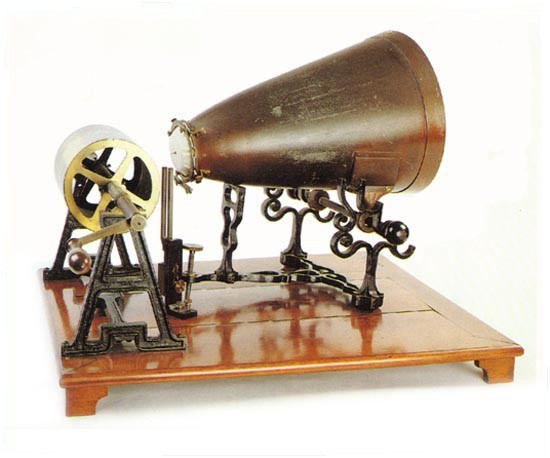The phonautograph, the first machine ever to record sound, was invented during the Second Empire, in 1853, by the Frenchman Édouard-Léon Scott de Martinville (1817-1879). Using a technique analogous to that of today’s seismometer (which converts earth tremors into a visual signal), the phonoautograph consisted of a membrane, placed at the end of an acoustic tube, which transmitted the vibrations created by a sound (for example a voice speaking into the open end of the tube) to a stylus which then engraved those vibrations onto specially prepared paper, blackened with smoke from an oil lamp and rolled around a cylinder. Scott de Martinville’s machine did not, however, allow the recorded sound to be replayed, it merely recorded a visual representation of it. The apparatus was eventually forgotten, surpassed by the work of Edison, Graham Bell and Tesla on the electrical transmission of sound and its recording, nearly twenty years later.
Scott de Martinville was an unknown pioneer and polymath. As a typesetter, publisher and bookseller, his work as a typographer and as a stenographer led him to want to make note-taking easier, hence his interest in recording sound to help him reproduce the texts dictated to him as faithfully as possible. In fact, his “History of shorthand from ancient times to the present day” (Histoire de la sténographie depuis les temps anciens jusqu’à nos jours), written in 1849, also aimed at improving shorthand accuracy.
Though an amateur, Scott de Martinville was also fascinated by science. Notably, he devoured all recent publications relating to the science of acoustics and was particularly interested in the functioning of the human ear drum. Inspired by this natural phenomenon, he developed the phonautograph in the space of five years, applying for a patent in 1857. He then joined forces with Rudolph Koenig (1832-1901), maker of scientific instruments, in particular high-precision tuning forks and later the manometric flame apparatus, who had been apprenticed to the luthier Jean Baptiste Vuillaume. Koenig was obsessed with the transmission and propagation of sound waves and the scientific implications of the acoustic phenomenon. The research interests of the two men were soon to diverge, with Scott de Martinville preferring research specifically on the possibilities of recording the human voice. Lack of funds however forced him to abandon further research. Koenig on the other hand continued to manufacture and improve the phonautograph, though it quickly became obsolete. Scott de Martinville – somewhat bitter when, twenty years after he had initiated the process of recording sound, Thomas Edison succeeded in not only recording sound but resurrecting it as an audible signal – then attempted to have the merits of the phonautograph recognised, but without success. Consequently, he resigned himself to returning once again to the selling of prints and books, finally dying in 1879, unrecognized as the pioneer of sound that he had strived so hard to be.
Until recently, the earliest recording of a voice was considered to be that of the song “Mary had a Little Lamb”, engraved on aluminium foil in 1877 by Thomas Edison. But in 2008, a collective of researchers “First Sounds” led by David Giovannoni were able, in collaboration with the Lawrence Berkeley National Laboratory, to convert a phonautogram produced by Scott de Martinville in 1860 into an audible sound file. We can now listen to a slow version of the first words of “Au clair de la lune”, (which some believe was sung by Scott de Martinville himself), making it the earliest recording of a human voice and indeed of a song in the world.
The First Sounds-Lawrence Berkeley National Laboratory collaboration has since “translated” into sound a dozen or so other high-resolution scans of Scott de Martinville’s phonautograms produced between 1857 and 1860. These sound files are now deposited in France at the Académie des Sciences and are also available on the Internet.
One of the last major rediscoveries in the field of sound history (made in 2013) was that of an 1885 recording of the voice of Alexander Graham Bell.
Marie de Bruchard, June 2017 (English translation Rebecca Young)
More information about Édouard-Léon Scott de Martinville (1817-1879) and his research http://www.firstsounds.org/research/scott.php
Serge Benoit, Daniel Blouin, Jean-Yves Dupontet and Gérard Emptoz published a detailed article (in French) on the Scott de Martinville’s invention in the Documents de l’histoire des techniques.


